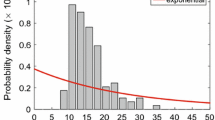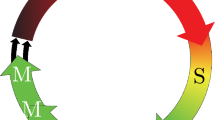Abstract
The Glazier–Graner–Hogeweg (GGH) model is a cellular automata framework for representing the time evolution of cellular systems, appealing because unlike many other individual-cell-based models it dynamically simulates changes in cell shape and size. Proliferation has seen some implementation into this modelling framework, but without consensus in the literature as to how this behaviour is best represented. Additionally, the majority of published GGH model implementations which feature proliferation do so in order to simulate a certain biological situation where mitosis is important, but without analysis of how these proliferation routines operate on a fundamental level. Here, a method of proliferation for the GGH model which uses separate cell phenotypes to differentiate cells which have entered or just left the mitotic phase of the cell cycle is presented and demonstrated to correctly predict logistic growth on a macroscopic scale (in accordance with experimental evidence). Comparisons between model simulations and the generalised logistic growth model provide an interpretation of the latter’s ‘shape parameter’, and the proliferation routine used here is shown to offer the modeller somewhat predictable control over the proliferation rate, important for ensuring temporal consistency between different cellular behaviours in the model. All results are found to be insensitive to the inclusion of active cell motility. The implications of these simulated proliferation assays towards problems in cell biology are also discussed.





Similar content being viewed by others
References
Abercrombie M, Heaysman JEM (1954) Observations of the social behaviour in tissue culture: II. ”Monolayering” of fibroblasts. Exp Cell Res 6:293–306
Barrandon Y, Green H (1987) Cell migration is essential for sustained growth of keratinocyte colonies: the roles of transforming growth factor-\(\alpha \) and epidermal growth factor. Cell 50:1131–1137
Bauer A, Jackson T, Jiang Y (2007) A cell-based model exhibiting branching and anastomosis during tumor-induced angiogenesis. Biophys J 92:3105–3121
Chaplain M, Stuart A (1993) A model mechanism for the chemotactic response of endothelial cells to tumour angiogenesis factor. IMA J Math Appl Med Biol 10:149–168
Chaturvedi R, Izaguirre J, Huang C, Cickovski T, Virtue P, Thomas G, Forgacs G, Alber M, Hentschel G, Newman S, Glazier J (2003) Multi-model simulations of chicken limb morphogenesis. Lect Notes Comput Sci 2659:39–49
Chen C, Mirksch M, Huang S, Whitesides G, Ingber D (1997) Geometric control of cell life and death. Science 276:1425–1428
Cone C Jr, Tongier M Jr (1973) Contact inhibition of division: involvement of the electrical transmembrane potential. J Cell Physiol 82(3):373–386
Coomber B, Gotlieb A (1990) In vitro endothelial wound repair: interaction of cell migration and proliferation. Arteriosclerosis 10:215–222
Farooqui R, Fenteany G (2005) Multiple rows of cells behind an epithelial wound edge extend cryptic lamellipodia to collectively drive cell-sheet movement. J Cell Sci 118:51–63
Folkman J, Moscona A (1978) Role of cell shape in growth control. Nature 273:345–349
Graner F, Glazier J (1992) Simulation of biological cell sorting using a two-dimensional extended Potts model. Phys Rev L 69(13):2013–2016
Hanahan D, Weinberg R (2000) The hallmarks of cancer. Cell 100:57–70
Hogeweg P (2000) Evolving mechanisms of morphogenesis: on the interplay between differential adhesion and cell differentiation. J Theor Biol 203:317–333
Huang S, Ingber D (1999) The structural and mechanical complexity of cell growth control. Nat Cell Biol 1:E131–138
Huttenlocher A, Lakonishok M, Kinder M, Wu S, Truong T, Knudsen K, Horwitz A (1998) Integrin and cadherin synergy regulates contact inhibition of migration and motile activity. J Cell Biol 141(2):515–526
Jiang Y, Pjesivac-Grbovic J, Cantrell C, Freyer J (2005) A multiscale model for avascular tumor growth. Biophys J 89:3884–3894
Jones L, Gray M, Yue S, Haugland R, Singer V (2001) Sensitive determination of cell number using the CyQUANT cell proliferation assay. J Immunol Methods 254:85–98
Jorgensen P, Tyers M (2004) How cells coordinate growth and division. Curr Biol 14:R1014–R1027
Kippenberger S, Bernd A, Loitsch S, Guschel M, Mller J, Bereiter-Hahn J, Kaufmann R (2000) Signalling of mechanical stretch in human keratinocytes via MAP kinases. J Invest Dermatol 114:408–412
Knewitz M, Mombach J (2006) Computer simulation of the influence of cellular adhesion on the morphology of the interface between tissues of proliferating and quiescent cells. Comput Biol Med 36:59–69
Li J, Lowengrub J (2014) The effects of cell compressibility, motility and contact inhibition on the growth of tumor cell clusters using the Cellular Potts Model. J Theor Biol 343:79–91
Maini P, McElwain DLS, Leavesley D (2004) Travelling waves in a wound healing assay. Appl Math Lett 17:575–580
Martz E, Steinberg M (1972) The role of cell-cell contact in contact inhibition of cell division: a review and new evidence. J Cell Physiol 79(2):189–210
Merks R, Perryn E, Shirinifard A, Glazier J (2008) Contact-inhibited chemotaxis in de novo and sprouting blood-vessel growth. PLoS Comput Biol 4(9):e1000163
Murrell M, Kamm R, Matsudaira P (2011) Tension, free space, and cell damage in a microfluidic wound healing assay. PLoS One 6:e24283
Ouchi N, Glazier J, Rieu J, Upadhyaya A, Sawada Y (2003) Improving the realism of the cellular Potts model insimulations of biological cells. Phys A 329:451–458
Pardee A (1974) A restriction point for control of normal animal cell proliferation. Proc Natl Acad Sci USA 71:1286–1290
Pearl R (1927) The growth of populations. Q Rev Biol 2:532–548
Poplawski N, Agero U, Gens J, Swat M, Glazier J, Anderson A (2009) Front instabilities and invasiveness of simulated avascular tumors. Bull Math Biol 71:1189–1227
Poplawski N, Swat M, Gens J, Glazier J (2007) Adhesion between cells, diffusion of growth factors, and elasticity of the AER produce the paddle shape of the chick limb. Phys A 373:521–532
Poujade M, Grasland-Mongrain E, Hertzog A, Jouanneau J, Chavrier P, Ladoux B, Buguin A, Silberzan P (2007) Collective migration of an epithelial monolayer in response to a model wound. Proc Natl Acad Sci USA 104(41):15988–15993
Puliafitoa A, Hufnagela L, Neveua P, Streichanb S, Sigalc A, Fygensond K, Shraimana B (2012) Collective and single cell behavior in epithelial contact inhibition. Proc Natl Acad Sci USA 109:739–744
Simpson M, Merrifield A, Landman K, Hughes B (2007) Simulating invasion with cellular automata: connecting cell-scale and population-scale properties. Phys Rev E 76:021918
Sisken J, Morasca L (1965) Intrapopulation kinetics of the mitotic cycle. J Cell Biol 25:179–189
Stott E, Britton M, Glazier J, Zajac M (1999) Stochastic simulation of benign avascular tumor growth using the Potts model. Math Comput Model 30:183–198
Timpe L, Martz E, Steinberg M (1978) Cell movements in a confluent monolayer are not caused by gaps: evidence for direct contact inhibition of overlapping. J Cell Sci 30:293–304
Tremel A, Cai A, Tirtaatmadja N, Hughes B, Stevens G, Landman K, O’Connor A (2009) Cell migration and proliferation during monolayer formation and wound healing. Chem Eng Sci 64:247–253
Trepat X, Wasserman M, Angelini T, Millet E, Weitz D, Bulter J, Fredberg J (2009) Physical forces during collective cell migration. Nat Phys 5:426–430
Turner S, Sherratt J (2002) Intercellar adhesion and cancer invasion: a discrete simulation using the extended Potts model. J Theor Biol 216:85–100
Turner S, Sherratt J, Cameron D (2004) Tamoxifen treatment failure in cancer and the nonlinear dynamics of TGF-\(\beta \). J Theor Biol 229:101–111
Tyson J, Novak B (2001) Regulation of the eukaryotic cell cycle: molecular antagonism, hysteresis, and irreversible transitions. J Theor Biol 210:249–263
Ura H, Takeda F, Okochi H (2004) An in vitro outgrowth culture system for normal human keratinocytes. J Dermatol Sci 35:19–28
Zahm J, Kaplan H, Herard A, Doriot F, Pierrot D, Somelette P, Puchelle E (1997) Cell migration and proliferation during the in vitro wound repair of the respiratory epithelium. Cell Motil Cytoskelet 37:33–43
Author information
Authors and Affiliations
Corresponding author
Electronic supplementary material
Below is the link to the electronic supplementary material.
Rights and permissions
About this article
Cite this article
Lawson, B.A.J., Pettet, G.J. Space-Limited Mitosis in the Glazier–Graner–Hogeweg Model. Bull Math Biol 79, 1–20 (2017). https://doi.org/10.1007/s11538-016-0204-y
Received:
Accepted:
Published:
Issue Date:
DOI: https://doi.org/10.1007/s11538-016-0204-y




